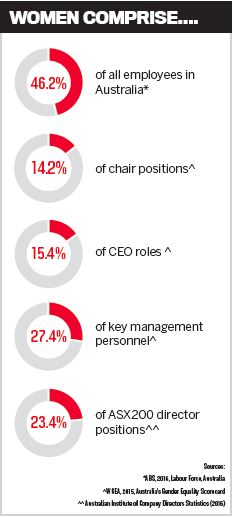
While improvements have been made, more needs to be done on gender equality in the top ranks of organisations

While improvements have been made, more needs to be done on gender equality in the top ranks of organisations. It’s time for D&I commitments to move beyond just a tick of the box
Looking for a damning D&I statistic? You don’t need to look far – here’s a few: there are fewer women CEOs and chairs (19 in total) of ASX200 companies than men named John (32). Further, the number of female executives in those companies actually fell between 2016 and 2017*. And according to research by the Institute of Company Directors, women account for just 25% of board positions within ASX 200 listed companies – although there is a goal to increase this to 30% by the end of 2018.
Gender diversity in the upper reaches of the corporate world is not a problem unique to Australia. Women make up less than 5% of CEO positions in the 500 largest US public companies, according to Catalyst, an advocacy group for female executives.
In addition, research from LeanIn.org and McKinsey & Co indicates that for every 100 women who get promoted from an entry-level position to manager, 130 men advance. The gap is largest at the critical point when they first move into top leadership roles.
Despite years of talking about the need for greater diversity, it seems results are slow to come. This incremental progress is grist for the mill for pessimists. However, for Karlie Cremin, principal at DLPA, it’s important to acknowledge that while there is still a long way to go, it’s also worthwhile applauding how far we have come.
“Even the fact you and I are now discussing this as a serious talking point is significant movement from a not too distant past,” she says.
However, a pressing question remains: what is hampering diversity efforts? Cremin believes that most businesses still do not believe diversity is a commercial decision, but rather an ethical or social one.
“When there is pressure on the bottom line, of course, focus shifts to the commercial levers,” she says. “I think we will see the meaningful change when there is a clear correlation drawn between diversity and commercial outcomes.”
Support is critical
Over many years, HRD has interviewed countless female HR leaders. A recurring theme has been a lack of female mentors at the top – and leadership can be particularly lonely if there is a lack of support. Cremin, who has worked in male-dominated industries her entire working career, and who took her first board position when she was 22, empathises with that viewpoint. However, she does not believe this is a gender-specific issue.
“One of the challenges when trying to address inequity, or increase diversity, is that we don’t inadvertently create prejudice through our well-intentioned actions,” she explains. “I think that it is a mistake to point to the cause of that loneliness and isolation as being gender based – ie, I have no female colleagues and therefore don’t have peers. Defining the problem in these terms actually perpetuates the problem.”
She adds that senior roles can feel very lonely – for any gender.
“I believe that we as individuals will never be so keenly aware of the ways we are different than when we hold those senior roles. Senior roles are terrifying, exciting and exposing, so it is important to have a mentor who can help us to be confident in who we are,” Cremin says.
“That said, a unique set of challenges do face most women who try to break through into senior roles. I think support is key, and that needs to come from a diverse range of sources, including men and women. I also think there is a danger in women trying to act like other female leaders they have seen. The most effective leaders find their own style and voice.”
The problem runs deeper…
For many people, including Cremin, the hope is that when enough women break into senior roles, it becomes self-perpetuating and junior female employees don’t even consider that moving up the hierarchy might be out of the question.
Encouragingly, many of the young women Cremin speaks to actually state they don’t believe there is gender-based prejudice in their workplace, or that any roles would be off limits for them on the basis of being female. However, there’s still a deep-rooted problem.
“My concern is that this is actually pointing to a much more insidious form of prejudice, where discrimination is not even recognised as valid,” Cremin says. “This point of view, which so many young women have expressed to me, also concerns me on the grounds that it points to a very simplistic understanding of how the current under-representation of women in senior roles came to be. It feels like a backwards step in many regards. The realities may not be realised until these women are attempting to get into the more senior roles – at which point the opportunity for change will have passed.”
Cremin believes the issue is likely to be more structural than mindset-based for women moving into management roles today. She says workplaces are still “remarkably inflexible – and to be fair so are many workers”.
She feels the critical ingredient for achieving higher levels of female participation is for organisations and workers to partner and collaboratively formulate solutions and work constructs that allow women to more comfortably move into senior roles, without feeling like they have to choose between senior roles and family, for example.
“If we want to see sustainable change in our workforce, we need to change the way we work as well,” she says.

One of DLPA’s bespoke offerings is called The Feminine Leader, a program uniquely designed to leverage any team’s diversity to generate effective organisational outcomes.
Cremin says the course came about through DLPA’s co-principal Lenore Miller and herself discussing everything they wished they’d known at the start of their careers, and realising that they could share those lessons with others.
“Women often fall into the trap of mimicking the masculine leadership traits they have seen modelled and, in the process, lose their own unique voice,” Cremin says.
To combat this, The Feminine Leader focuses on supporting participants to find their unique leadership brand as they seek or come into executive or management roles. The course is structured around identifying how you can be most effective as a leader, and then developing the confidence and skills to communicate that style in way that others will hear and understand.
The course also provides a support network for participants to interact with each other, coaches, Miller and Cremin as they progress and encounter new challenges. This helps ensure that participants have access to the help they need beyond the program as well.
Cremin says the course attracts a wide range of participants, some of whom are already in senior roles but may be feeling overwhelmed and ineffective. In other instances, it’s a conflict that prompts people to enroll in the course. Other participants have included young workers who have been earmarked for future management positions, people newly appointed to management positions, and people looking for their first executive role, as well as long-standing executives.
The course is run in a small group environment (a maximum of 20 people), which means that DLPA is able to tailor and pitch the content to the people in the room.
“The reality is that we all always have more to learn and ways we could further develop, so this flexibility in delivery means the program is relevant to almost anyone,” Cremin says.
A group effort
While programs like DLPA’s The Feminine Leader can certainly help with D&I outcomes, Cremin says society as a whole must decide that diversity matters beyond just a tick of the box. Does she believe diversity is something that can be taught?
“Like any habit, yes it can be taught from a compliance standpoint – that is, we all go through the motions of our diversity checklist and we will see an improvement in the workforce stats. However, this is unlikely to yield meaningful change in my view. Organisations need to get serious about actual diversity in their workforces – where the differences within the group are leveraged for competitive advantage not just managed,” she says.
Once organisations make this shift then it’s a matter of educating the workgroup about issues such as unconscious bias and celebrating difference. However, more critically, Cremin says every individual within an organisation needs to take responsibility for the role they play in the diversity or otherwise of their organisation.
“If nothing else, I think it has become clear that we are so far down the exclusion path that diversity and full participation in the workforce, particularly at senior levels, is not going to occur by accident. It will need to be a conscious decision, followed by meaningful, directed action,” she says.
*Based on an analysis by economist Conrad Liveris, published in a report titled: To Be Meritorious: Gender Equality at Work in 2017.
DLPA
Dynamic Leadership Programs Australia (DLPA) is a bespoke leadership and business development program provider that drives strategic objectives and unlocks the potential of current and emerging leaders. Corporate strategy is at the heart of DLPA’s programs, and our team works hand in hand with each client to identify key barriers to their success, develop leadership skills, align organisational values, and empower people to reach higher levels of performance. For further information email [email protected]